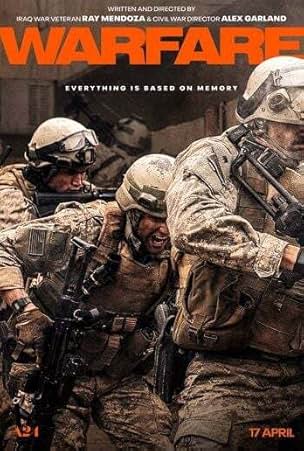Director Alex Garland teams up with a veteran/filmmaker Ray Mendoza, the military adviser on “Civil War” (2024), to make Mendoza’s feature film debut, “Warfare” (2025), which is Mendoza’s account of one day, November 19, 2006, in the Battle of Ramadi, Iraq and is not a documentary. A team of Navy SEALs takes sniper positions to support the US Marines, but their position is spotted soon after they occupy an Iraqi two-unit apartment building, and they are soon under siege. Will they get out alive?
“Warfare” is not a conventional film. It purports to take place in real time. “The film only uses their memories” flashes onscreen close to the beginning of the film. What is not based on memories? There are characters, but they are shown for a limited period in a vacuum, a slice of life, a fraction of a nightmarish day. In real-life, Navy SEALs go through a rigorous selection and training process. The film gives no sense of how many missions these men have been on together, if this mission was typical or not (inferring the latter), if there were men not present who normally would be or vice versa, who is the weakest leak, what they are like on a normal day. They know each other and see each other as individuals even though they act as a team, but to the moviegoer, while they are distinctive, there is a nameless, interchangeable quality. The movie is mostly adrenaline filled and intense. It frames a siege in a very particular way that is not real. It would have to be a television series to truly capture every facet of the group and individual development dynamics. If warfare is defined as actively fighting and not the preparation leading up to it, the movie would start once they landed in Iraq. It is important to interrogate definitions of what is real, because the realness is the lure to attract audiences, but looking for vicarious thrills in the safety of a movie theater is not warfare, but an amusement park ride if people are just looking for enjoyment and do not actually care about the men on screen in a way that recognizes that this representation of pain, blood and death really happened. Real is smell, taste and fear, which a movie cannot truly convey though it does its best with what is possible.
Part memoir, part found footage, all war movie, “Warfare” is the latest in Garland’s elevated Roland Emmerich cycle where he takes real life concerns or in this case historical battles, drains context and leaves spectacle. He is the twenty-first century’s version of William Castle promising a viewing experience that will feel and sound real if you see his movie in a Dolby theater. It is the way that Garland distinguishes himself from Christopher Nolan’s “Dunkirk” (2017) and Sam Mendes “1917” (2019) with the additional challenge of being set in the twenty-first century. If you want to live vicariously through these men, then you must go to the theatre. No streaming!
Just because a movie goer experiences the limited horrors of war does not mean that they will derive the right lessons from it. It is war as entertainment, not necessarily a cautionary tale, regardless of Garland and Mendoza’s intent. Based on the dedication that appears at the end of “Warfare,” Mendoza wanted to capture his memories on film since his platoonmate, Elliot, did not remember what happened to him. Mendoza’s story is not Elliot’s, but it is an attempt at preserving history and employing veterans, which are undeniably laudable goals. Is a fictional film, even with the benefit of a first-hand account, history? It depends. Movies, even documentaries, are not required to meet certain academic standards or be accurate.
While watching “Warfare,” it will be initially challenging to recall the characters’ names though you may gradually pick up on them. D’Pharaoh Woon-A-Tai plays Ray and is usually on the radio asking for support or offering information, sitting or kneeling and taking notes. It is good that he gets an opportunity to show his acting chops more than in his most recent prior role in “Hell of a Summer” (2025). Cosmo Jarvis plays Elliott, who is shown as the first sniper sporting a mustache and lying on bedding at a hole in the wall. It is an ensemble cast where no character is supposed to stand out in the team. Though Will Poulter does an excellent job as the team captain, Erik, it was a mistake to cast him because some may associate a uniformed Poulter with his performance in “Detroit” (2017), and that would convey the wrong message. He is a little too famous and distinctive to blend in. As Sam, Joseph Quinn, who is currently more famous than Poulter, but is more like a chameleon, was exuding James McAvoy energy of grabbing the camera’s attention before he is supposed to. Michael Gandolfini, who is having an excellent run as a lead supporting character in “Daredevil: Born Again” (2025), appears as Lt. Macdonald, but could easily be missed except for him messing with Sgt Laerrus (Adain Bradley). Gandolfini may be one of the few Americans in the joint. Though his name may not be recalled, the baby-faced new guy is Tommy (Kit Connor).
Stay for the end because real-life photos of the characters are shown next to the actors, but “Warfare” made a crucial mistake. Garland and Mendoza chose not to put the names of the characters under their photographs. It could be an effort to keep their identities classified, especially since some of their faces are blurred in photographs because they may still be working in the field in another capacity, i.e. to keep them safe. There is a cast list, and every character has a name except if the character was attacking the Americans. This choice is the moment where the suspension of disbelief gets lost. If it was about memorializing history, when the men have a moment to be remembered as individuals, they are still nameless and more associated with the actor than the real-life person. In contrast, “My Dead Friend Zoe” (2025), another veteran/filmmaker feature debut released earlier this year, took the time to honor individual valor at the end. There is an unintentional dehumanizing effect when individuals remain nameless, faceless and fully immersed in a group long after the group is disbanded people.
If there was a moment when you would not care about accuracy, it is when Charles Melton appears on screen. His character, Jake, immediately instills confidence, and he is more individuated and distinctive than the onscreen Mendoza surrogate (through no fault of the actor). If there is ever a moment in the film that seems like pro-American propaganda, it is every scene that he is as the embodiment of American ideals about servicemen. Even when he hilariously and deliciously breaks the rules to the save the day (duh Mendoza is directing “Warfare” so it should not be a spoiler), he fits our ideals of the maverick.
Even though “Warfare” does not take sides, it does feel as if Mendoza and Garland are making this film as a tacit apology to the Iraqis whom the operation disproportionately affected though they were not complicit with the enemy or even were allies. It is not part of Mendoza’s memories or any of the Navy SEALs how the tenants of the occupied house reacted after they left. Unless Mendoza spoke their language, Mendoza did not know the interpreters’ articulated misgivings. They were preoccupied that their safety was not considered. Mendoza imagined their concerns.
“Warfare” does not need the gimmick of being part of eyewitness memory to be an impressive movie. By activating the critical brain, it detracts from appreciating what the movie does accomplish. The work stands on its own without the veneer of authenticity. It is a movie that will elicit instinctual empathy with the characters on screen because it is not just projected images, but sound that shakes every chair in the theater and transcends space, time and the gap between imagination and experience.





